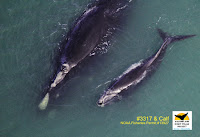The mother and calf right whales spotted yesterday off S. Ponte Vedra were initially sighted by our colleagues on the Florida Fish and Wildlife Conservation Commission aerial survey team. Since the whales were about 5 miles north of the St. Augustine Inlet, Jim relayed their coordinates to the Air Cam crew to conduct follow up documentation. With excellent weather conditions, the Air Cam team spotted the pair and succeeded in obtaining photographs.
 The mother is Catalog #3317, a 13-year-old whale with her second calf. We saw her in our area in 2003, when she was a calf, and again in 2006 as a juvenile. She and her calf were first sighted this season on 10 December by the FWCC aerial team.
The mother is Catalog #3317, a 13-year-old whale with her second calf. We saw her in our area in 2003, when she was a calf, and again in 2006 as a juvenile. She and her calf were first sighted this season on 10 December by the FWCC aerial team.
To the south, two right whales were reported in the Cape Canaveral area on 19 January. Our colleague, Julie Albert of Marine Resources Council, verified them to be a mother and calf and obtained photos. The mother has been identified as Catalog #3450 (Clipper) with her first known calf.
This brings the total number of calves born this season to eight! Progress indeed. Plus, we know that at least one pair of whales has traveled through our area. We have to think that more will follow as the sea surface temperatures take on the profile that, in the past, has generally been correlated with sightings on our area. Take heart and keep looking seaward!

